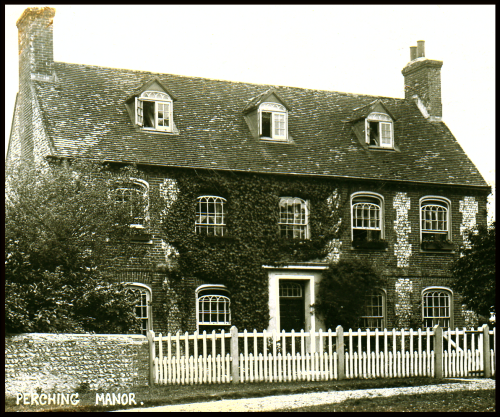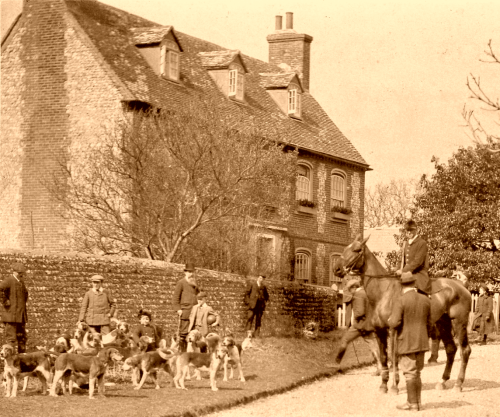Apart from St. Andrew’s Church, Perching Manor [Farmhouse] is the only Grade II* listed building in Fulking and Edburton. It is the eighteenth century farmhouse for Perching [Manor] Farm, and it retained its traditional role of providing a home for the farmer until 1984. Modern official records typically refer to the house as ‘Perching Manor Farmhouse’, presumably to distinguish it from the original medieval manor house whose remains lie beneath a nearby field, but the house has been known to locals as ‘Perching Manor’ for well over a hundred years (the 1861 census lists it as ‘Perching House’ whilst the subsequent nineteenth century censuses have it as ‘Manor House Perching’).

An L-shaped eighteenth century farmhouse, with Gothicized windows; two storeys and attic; five rooms wide; three dormers. Faced with square knapped flints with red brick window dressings, quoins, stringcourses, modillion eaves course and panels between the ground and first floor windows. Tiled roof. Windows with segmental heads and pointed Gothic glazing. The dormers contain casement windows and have artificial depressed heads which have Gothic panes in the sash windows below. Doorway with pilasters, projecting cornice, fanlight glazed with same pattern as the windows and door of six moulded panels.
[Howe 1958, pages 32-33]
The front (east) elevation is of a different design to the back (west), which suggests that the front of the house was extended in the late eighteenth century. A beam, believed to be a chimney beam salvaged from the medieval manor house, is now located over the fireplace in the kitchen. The interior of the house has been modernised but, as can be seen from the illustrations above and below, the exterior has barely changed over the years for which we have a photographic record. In the 1990s, a separate building, which houses a swimming pool, was built in the north east corner of the property where once a rhubarb bed flourished.
In 1835, Nathaniel Blaker took over the tenancy of the farm from Richard Marchant, whose family had lived in the parish for more than a century, and moved from Selmeston to Perching Manor with his wife Elizabeth and their infant son. The son, Nathaniel Paine Blaker [NPB] was to become a distinguished surgeon and, late in life, the author of a memoir that has much to say about life in Fulking in the middle of the nineteenth century. The 1841 census reveals that the Blakers had five servants at that time, more than any other family in the parish. Among them was Charlotte Paine, aged 13, who was NPB’s nanny. The household is much the same ten years later although Elizabeth’s widowed mother has joined them. The five servants then include a cook and a groom but the nanny is gone — NPB is sixteen. He tells the following anecdote about his father:
Among other things, my father had learned to “hold plough”, a not very easy accomplishment, as anyone not accustomed to it is likely to find by receiving a blow in the face from the plough handles. One day he had occasion to find fault with the carter for not ploughing the ground properly. The man replied: “Then you’d better do it yourself”. My father answered: “Stand aside and I will”. He ploughed one or two furrows, and handed back the plough to the man, who remained with him, an excellent servant, for fourteen years, and died in the Sussex County Hospital, when I was House Surgeon. [Blaker 1919, pages 1-2]

A map of the Perching Farm buildings in 1842, during Nathaniel Blaker’s tenancy. Perching Manor is marked in red. The physical layout is much the same today except that the farm buildings have been converted for residential use. The current farm and farmhouse is slightly further north.

The grave of Selina and Eli Page in the churchyard of St. Andrew’s, Edburton.
In 1901, Nap Page took over running the estate.

Nap was named after one of the twelve tribes of Israel [Naphtali], his father being a baptist minister. As a young man he was inclined to wildness, and was said to have ridden on horseback down Devil’s Dyke for a wager. He also rode regularly to his cousin John Page at Lodge Farm, Ringmer, for all-night card sessions. Rather than stick to the roads, he would go across the fields, jumping the hedges. Several photos survive of Nap. One shows him with a hen on his knee — this was Chuckles who was supposed to have laid an egg for Nap in his bedroom each morning. Another photo shows him in a long coat and bowler hat supervising the annual sheep shearing, sometime before 1912. A further photo shows Nap’s funeral procession leaving for Edburton church, with his favourite horse following behind the bier.
[Wales 1999, page 109]
William Beard, who had known Nap when he was a young man, recollected that:
It was sometimes said by older men that Nap Page was not as good a farmer as his father, Eli, but all who knew him agreed that there was no more jovial or generous host than the Squire of Perching Manor. His rather early death was greatly deplored! His passing marked the end of a period — the Horse Age. [Beard 1954]
As this quotation suggests, Nap adopted the role of country squire, becoming a keen huntsman and entertaining in a lavish style. Unfortunately, his interest in farming was minimal and by the time he died in 1920, the farm had become badly neglected.

The South Down Foxhounds assembled outside Perching Manor in 1911 during the Nap Page tenancy.
During the war, a team of land girls came in for the harvests and the male workforce included two German and three Italian PoWs, the latter being billeted in the cellar at Perching Manor. The PoWs were repatriated in 1947 and 1948 and replaced by two displaced persons from Latvia. From around 1938 on, the farm acquired tractors and these rapidly displaced the horses and halved the workforce. After the war, three combine harvesters were purchased. During the 1950s, the farm holdings expanded to more than 2000 acres including 1000 acres for grain, 1000 sheep, and 250 cows bred for beef. When Henry Harris died in 1961, aged 72, his sons initially continued to run the farm as tenants of the Crown before Brian Harris took sole charge. In 1984, the Crown broke up the estate. The farm was sold to the National Freight Corporation and Perching Manor itself, which had always been the main farmhouse and the home of the farmer, was sold as a separate lot to the Dubrey family. The house remains in private ownership.

Tony Brooks
References
- William Beard (1954) Glimpses of past personalities. St. Andrews Quarterly 24.
- Nathaniel Paine Blaker (1919) Sussex in Bygone Days. Hove: Combridges.
- F.A. Howe (1958) A Chronicle of Edburton and Fulking in the County of Sussex. Crawley: Hubners Ltd.
- Tony Wales (1999) The West Sussex Village Book. Newbury: Countryside Books.
[Copyright © 2013, Anthony R. Brooks. Adapted from Anthony R. Brooks (2008) The Changing Times of Fulking & Edburton. Chichester: RPM Print & Design, pages 191-193.]
Currently popular local history posts:

